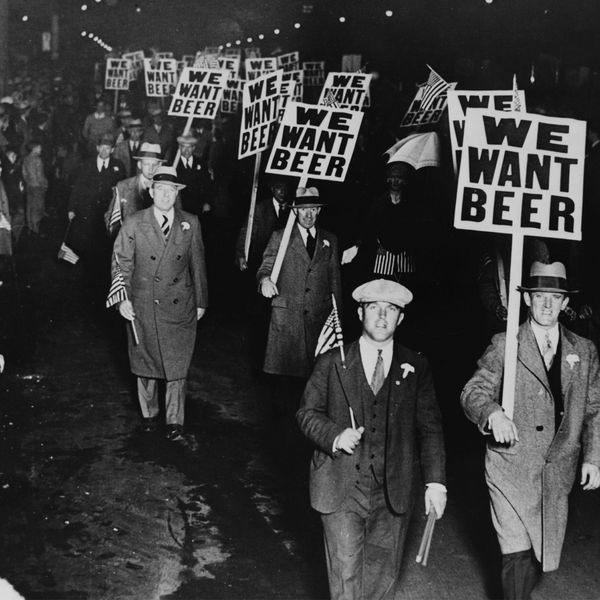In the 1920s alcohol consumption was at a world high. More than half of the population was getting drunk at night, some not even going home first, They would stay in the bars and come home sloppy drunk. The crime rates were up and the nation’s health risks were also up. Many families had to scrape together money because the men would spend it all at the bars as soon as they got paid and would not bring any back for the family to buy food with. Some of the women even had to work to compensate for the men not bringing anything home, which was highly looked down upon at this time. If the women did not go to work, some families would even go hungry because of this crisis.
Pre-History of Alcohol Prohibition
In the 1820s and 30s a wave of religious revivalism hit the United states. They were also known as “perfectionists movements”. This included very religious groups forming. These groups believed strongly against the consumption of alcohol. Maine was the first to pass state prohibition laws in 1846 followed by stricter laws in 1851. Many states followed this precedent by the time of the Civil War. These temperance societies were forming all across the nation. 1906 brought a new wave of attacks on bars and the sale of alcohol, this made it harder to obtain alcohol, and also made alcohol wanted more because of these attacks, which were led by the Anti-Saloon League (est. in 1893). In 1917 President Woodrow Wilson instituted a temporary wartime temperance act in order to save grain for World War 1.
Situation After WWI
After World War 1, the nation was broke, the men were tired, and many were depressed. . Since the 1830s alcohol consumption has increased with major social problems. This played itself out again after the war. The nation would turn to alcohol to temporarily numb the pain.
Women played a big role in prohibition. They believed that alcohol was tearing their families apart. Abuse was also happening due to the men being drunk when they came home. The Temperance Movement was now in effect, which was led by women. The Women’s Christian Temperance Union 2 was one of the biggest temperance unions at the time. These groups would hold peaceful protests and stand outside of bars and saloons and not let anyone in the bars. Some women would kneel in front of these bars and pray, blocking the paths into the bars; these would later be known as “pray-ins”. The bar owners would get mad and people would often throw food and beer at them, but they would still sit there and pray, as if nothing happened. These women believed so strongly in their views that they would risk their lives for it. They would also stand in front of these saloons and sing hymns in support for the temperance movement. The group went as far as buying ad signs and posting them on roads leading to the bars and saloons so the customers would see. They hoped to change their mind about going into these bars. Carrie Amelia Nation even went to the extreme and went into bars with a hatchet and broke all that she could. She walked into many bars doing this, she caught the bar owners by surprise but when the word got around they started closing and locking their doors and all the customers stood in front of the door so she could not enter.
The 18th Amendment
The 18th Amendment was passed and signed into law on January 29, 1919. This made it illegal to transport, sell, or manufacture alcohol in the United States. This amendment was supposed to end the consumption of alcohol, but it didn’t clearly make consuming alcohol illegal. Wine, beer, and spirits that were stashed away in peoples houses could be consumed in the luxury of their own home. The real effects of this amendment were bootleggers and speakeasies.
Bootleggers and Speakeasies
Bootleggers were the people who would illegally manufacture and sell the alcohol to other people. They would find hiding spots to hide their stills and only go to them at night because it was easier to get to them in the mask of night. Another kind was the ones that would sell stills and ingredients. One example of this was the Genna brothers. These brothers would go around house to house and sell one gallon copper stills, corn sugar, and yeast. They sold to big and little time illegal manufactures. The illegal liquor only cost them 50-75 cents per gallon but they made a good $15 a day ($ in today’s dollars).
Speakeasies were underground illegal barooms. They were named speakeasies because of how low you had to speak the “password” so police officers wouldn’t hear you. Though Woodrow Wilson thought this amendment was fool-proof, there were many loopholes in it. Bars stopped advertising that they sold alcohol, but didnt stop selling it. The bars would charge extremely high amounts of money for crackers and then give alcohol “for free”. These were called “blind pigs” or “gin joints”. In some of these establishments, you would know if it sold alcohol because of plastic or glass pigs sitting on the table.
In 1929 the Women’s Organization for National Prohibition Reform (WONPR) was founded.

